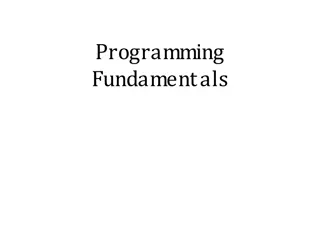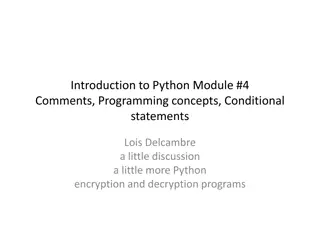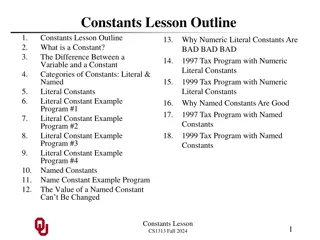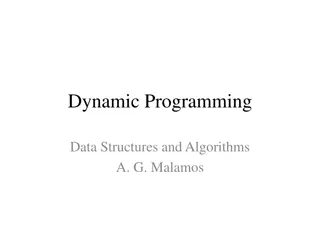Understanding Stronger vs. Weaker in Programming Concepts
Exploring the differences between stronger and weaker specifications in programming, along with insights on subtypes, subclasses, typing, generics, and method declarations. Learn how to differentiate, apply, and leverage these key programming concepts effectively to enhance code quality and maintainability.
Download Presentation

Please find below an Image/Link to download the presentation.
The content on the website is provided AS IS for your information and personal use only. It may not be sold, licensed, or shared on other websites without obtaining consent from the author. Download presentation by click this link. If you encounter any issues during the download, it is possible that the publisher has removed the file from their server.
E N D
Presentation Transcript
Stronger vs Weaker (one more time!) stronger Requires less? Promises more? (stricter specifications on what the effects entail) Throws more exceptions? stronger weaker
Stronger vs Weaker @requires snurf flarg @modifies blech murph @effects roar @throws woiefio fi gonzo A. @modifies blech murph @effects roar @throws woiefio fi gonzo B. @requires snurf flarg @modifies blech murph @throws woiefio fi gonzo C. @requires snurf flarg @modifies blech murph @effects roar STRONGER WEAKER STRONGER
Subtypes & Subclasses Subtypes are substitutable for supertypes If Foo is a subtype of Bar, G<Foo> is a NOT a subtype of G<Bar> Aliasing resulting from this would let you add objects of type Bar to G<Foo>, which would be bad! Example: List<String> ls = new ArrayList<String>(); List<Object> lo = ls; lo.add(new Object()); String s = ls.get(0); Subclassing is done to reuse code (extends) A subclass can override methods in its superclass
Typing and Generics <?> is a wildcard for unknown Upper bounded wildcard: type is wildcard or subclass Eg: List<? extends Shape> Illegal to write into (no calls to add!) because we can t guarantee type safety. Lower bounded wildcard: type is wildcard or superclass Eg: List<? super Integer> May be safe to write into.
Subtypes & Subclasses class Student extends Object { ... } class CSEStudent extends Student { ... } x ls = lcse; List<Student> ls; List<? extends Student> les; List<? super Student> lss; List<CSEStudent> lcse; List<? extends CSEStudent> lecse; List<? super CSEStudent> lscse; Student scholar; CSEStudent hacker; x les = lscse; x lcse = lscse; x les.add(scholar); x lscse.add(scholar); lss.add(hacker); x scholar = lscse.get(0); hacker = lecse.get(0);
Subclasses & Overriding class Foo extends Object { Shoe m(Shoe x, Shoe y){ ... } } class Bar extends Foo {...}
Method Declarations in Bar The result is method overriding The result is method overloading The result is a type-error None of the above Object Foo Bar Footwear Shoe HighHeeledShoe type-error FootWear m(Shoe x, Shoe y) { ... } Shoe m(Shoe q, Shoe z) { ... } overriding HighHeeledShoe m(Shoe x, Shoe y) { ... } overriding overloading Shoe m(FootWear x, HighHeeledShoe y) { ... } Shoe m(FootWear x, FootWear y) { ... } overloading overriding Shoe m(Shoe x, Shoe y) { ... } overloading Shoe m(HighHeeledShoe x, HighHeeledShoe y) { ... } Shoe m(Shoe y) { ... } overloading Shoe z(Shoe x, Shoe y) { ... } none (new method declaration)
Design Patterns Creational patterns: get around Java constructor inflexibility Sharing: singleton, interning, flyweight Telescoping constructor fix: builder Returning a subtype: factories Structural patterns: translate between interfaces Adapter: same functionality, different interface Decorator: different functionality, same interface Proxy: same functionality, same interface, restrict access All of these are types of wrappers
Design Patterns Interpreter pattern: Collects code for similar objects, spreads apart code for operations (classes for objects with operations as methods in each class) Easy to add objects, hard to add methods Instance of Composite pattern Procedural patterns: Collects code for similar operations, spreads apart code for objects (classes for operations, method for each operand type) Easy to add methods, hard to add objects Ex: Visitor pattern
Design Patterns Adapter, Builder, Composite, Decorator, Factory, Flyweight, Iterator, Intern, Interpreter, Model-View-Controller (MVC), Observer, Procedural, Prototype, Proxy, Singleton, Visitor, Wrapper What pattern would you use to add a scroll bar to an existing window object in Swing Decorator We have an existing object that controls a communications channel. We would like to provide the same interface to clients but transmit and receive encrypted data over the existing channel. Proxy When the user clicks the find path button in the Campus Maps application (hw9), the path appears on the screen. MVC Observer

















































